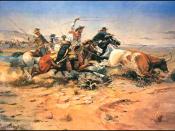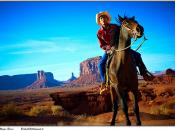Perhaps one of the most romanticized images in America at the turn of the century is that of the Wild West. One of the most celebrated images of the Wild West was that of the cowboy, America's defender of the frontier. The American cowboy became a figure of construction by businessmen and literature, and in recent years, a figure of reconstruction by modern historians. The businessmen and literature presented a highly glamorized view of the American cowboy that encouraged growth in the cattle industry and on the newly built railroads, and fed the imaginations of Americans. In attempts to disarm the inaccuracies of these cowboy myths, modern historians have emphasized the more dreary and difficult aspects of the cowboy's life. Although both sides draw on factual evidence, there is evidence of myth-making in both presentations.
LITERATURE
As early as the 1850s and 1860s, eastern journalists and dime novels began shaping America's cowboy mythology.
Literature portrayed the West as a place free from the corruption of civilization, and the frontiersman as "a kind of mythic American Adam--simple, virtuous, and innocent." As time progressed into the 1860s and 1870s, images appeared of the frontiersman as masculine and strong, defending the frontier. In 1872, Mark Twain's book Roughing It portrayed the West as a place where violence was commonplace. Authors such as Owen Wister portrayed cowboys as "wild men" who "sprang from the loins" of the West. His novel The Virginian of 1902 popularized the gun fight. Literature presented images of cowboys rescuing greenhorn Easterners and damsels in distress, or saving towns and homesteads from outlaws. "Their frontiersmen are leaders, pathfinders and explorers--men who venture forth to make conquered land safe for peaceful colonists. To be alone on the frontier is to be potentially heroic."
Eastern Imagination and Desire
As the 20th...



Excellent!
Congrats! Very nice work!
0 out of 0 people found this comment useful.